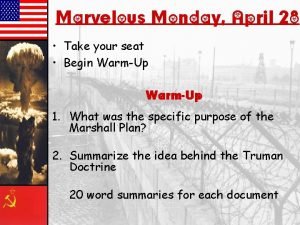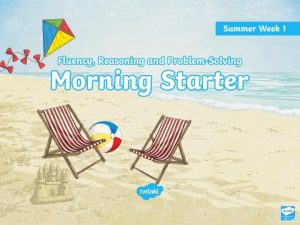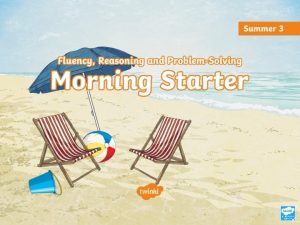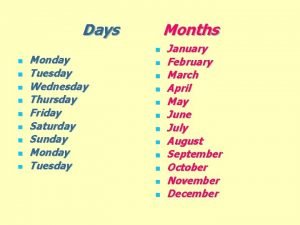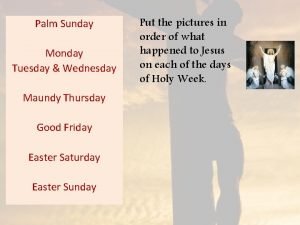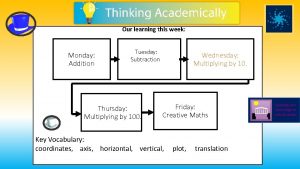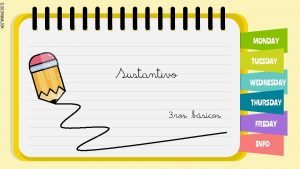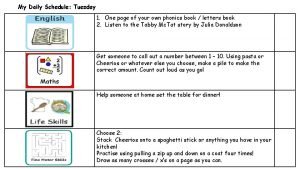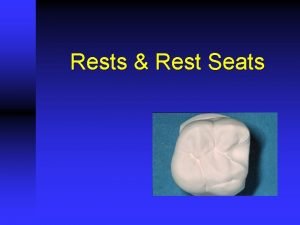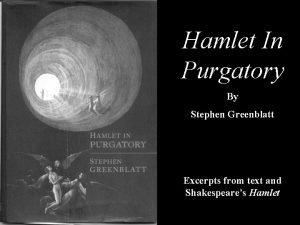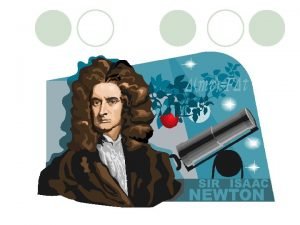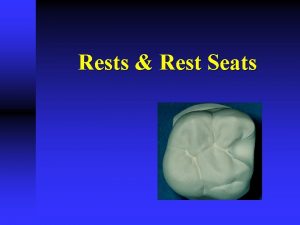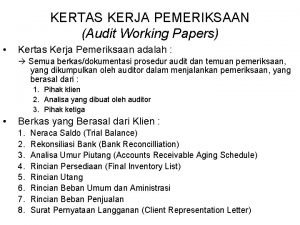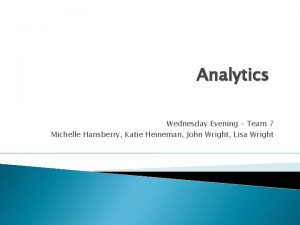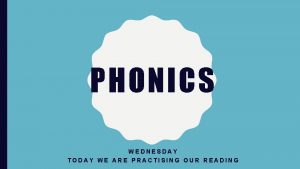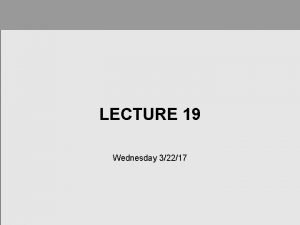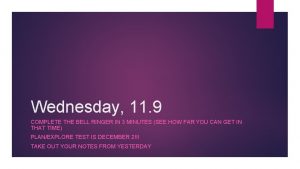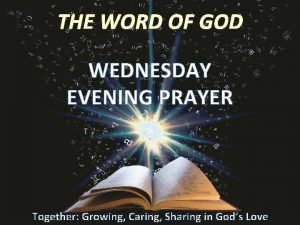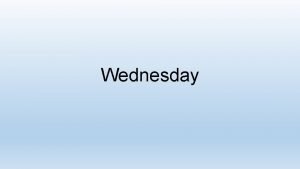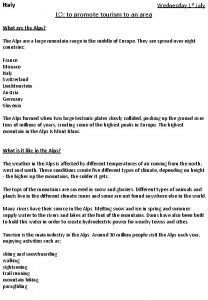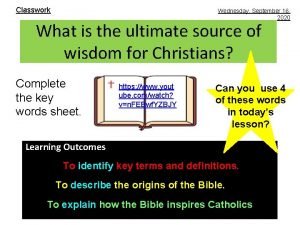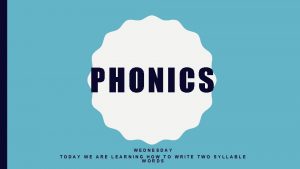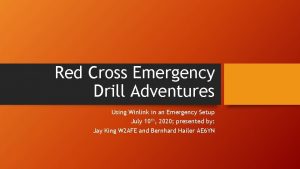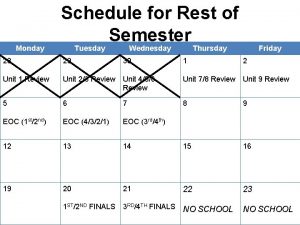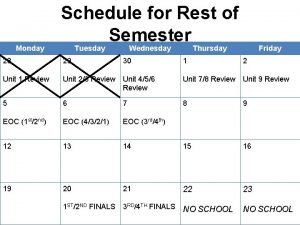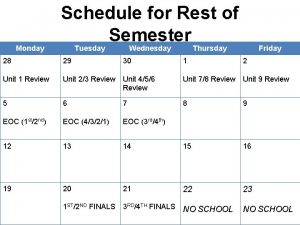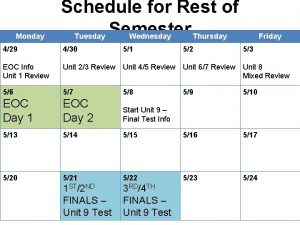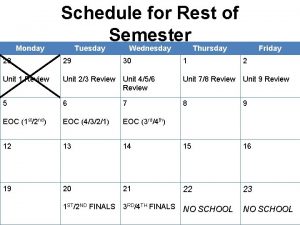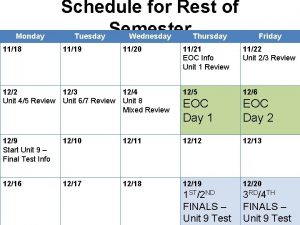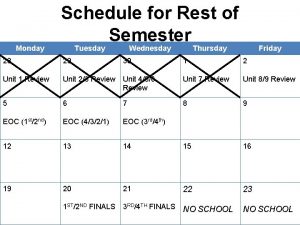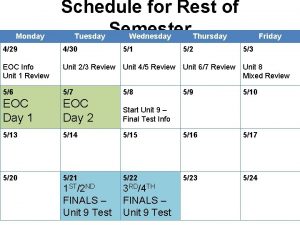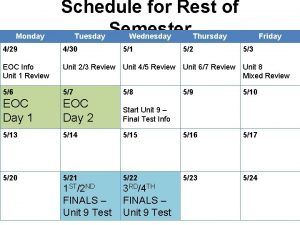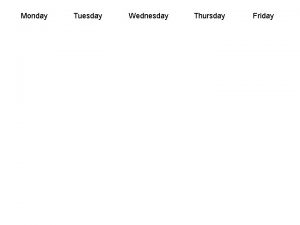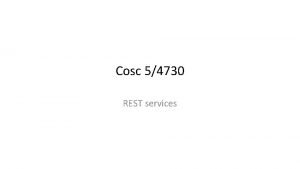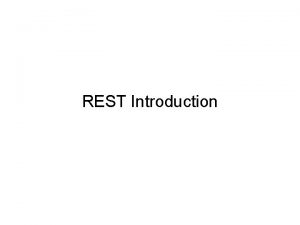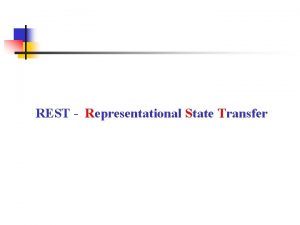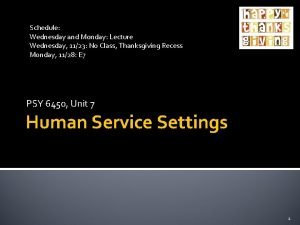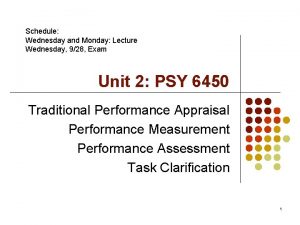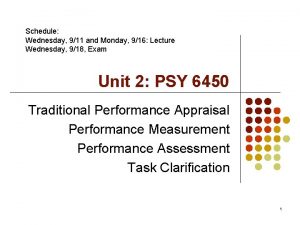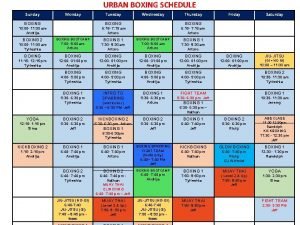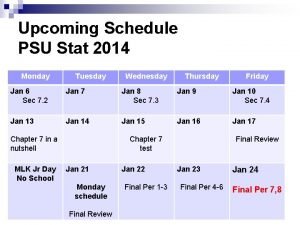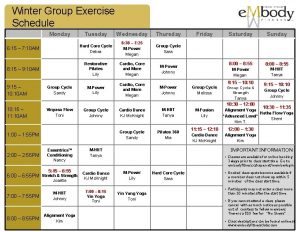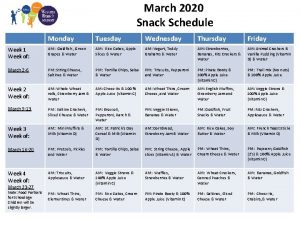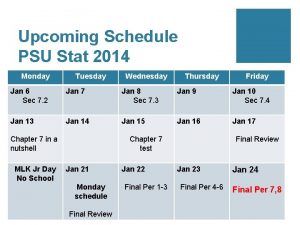Monday Schedule for Rest of Tuesday Semester Wednesday
































- Slides: 32

Monday Schedule for Rest of Tuesday Semester Wednesday Thursday Friday 4/29 4/30 5/1 5/2 5/3 EOC Info Unit 1 Review Unit 2/3 Review Unit 4/5 Review Unit 6/7 Review Unit 8 Mixed Review 5/6 5/7 5/8 5/9 5/10 EOC Day 1 EOC Day 2 Start Unit 9 – Final Test Info 5/13 5/14 5/15 5/16 5/17 5/20 5/21 5/22 5/23 5/24 1 ST/2 ND FINALS – Unit 9 Test 3 RD/4 TH FINALS – Unit 9 Test

END OF COURSE TEST

Monday 5/6 AND Tuesday 5/7 Do NOT be Tardy or Absent!!!

rd 3 Block: You need to eat A lunch. If you forget, or are late, you will not be admitted to test!

Want to figure out your grade? Current Grade*0. 8 + Possible EOC grade*0. 2 20%

Types of Questions

Where is my test? ! Meet in the testing location. Don’t be late! Ms. Wiggins Media Center Mrs. Mac Rm 1114 Mrs. Smith Rm 2411

What to do… 1. Sign onto computer. 2. Open DRC INSIGHT icon. 3. Select END-OF-COURSE (EOC)… Test Sign In. 4. Put phone on silent AND in your bag. Leave smart watches at home. 5. Take out pencil & calculator. 6. Place your bag in front of room.




Monday: • Section 1, 1: 10…NO calculator • Section 1, 2: 27…WITH calculator • 60 – 85 minutes TOTAL • 37 questions TOTAL

Tuesday: • Section 2: 36…WITH calculator • 60 – 85 minutes TOTAL • 36 questions TOTAL

SEATIN G

PENCILS & CALCULATO R

CELL PHONES AND SMART WATCHES

NAP TIME!

GSE Algebra I Day 1 Review

1: Relationships Among Quantities Key Ideas Properties of Rational and Irrational Numbers Reason Quantitatively and Use Units to Solve Problems Interpret the Structure of Expressions

Rational vs. Irrational Numbers Rational Irrational • A real number that can be • A real number that cannot represented as a ratio p/q be expressed as a ratio. such that p and q are both integers and q does not • Irrational numbers cannot equal zero. be represented by • All rational numbers can be decimals that stop or expressed as a decimal repeat. that stops or repeats. • Ex: √ 3, � , √ 5/2 • Ex: -0. 5, 0, 7, 3/2, 0. 26666

Sum and Product of Rational and Irrational Numbers • The sum of an irrational number and a rational number is always irrational. I+R=I • The product of a nonzero rational number and an irrational number is always irrational. Rx. I=I • The sum or product of rational numbers is rational. R+R=R Rx. R=R

Ex 2: Is the sum of ½ and √ 2 a rational or an irrational number?

Ex 3: Is the product of -0. 5 and √ 3 a rational or an irrational number? Explain your reasoning.

Level of Accuracy • A quantity can be exact or approximate. When an approximate quantity is used, it is important that we consider its level of accuracy. • For example, a dosage of medicine would need to be very precise. • An example of a measurement that does not need to be very precise is the distance from your house to a local mall.

Unit of Measure • If you want to calculate the diameter of the sun, you would want to choose a very large unit of measure of length, such as miles or kilometers. • Conversion of units can require approximations.

Ex 4: Convert 309 yards to feet.

Ex 5: The cost, in dollars, of a single-story home can be approximated using the formula C = klw, where l is the approximate length of the home and w is the approximate width of the home. Find the units for the coefficient k. k = C/lw or dollars per feet squared

Ex 6: Convert 45 miles per hour to feet per minute.

Ex 7: When Justin goes to work, he drives at an average speed of 65 miles per hour. It takes about 1 hour and 30 minutes for Justin to arrive at work. His car travels about 25 miles per gallon of gas. If gas costs $3. 65 per gallon, how much money does Justin spend on gas to travel to work? • 65 mph * 1. 5 hours =97. 5 miles • 97. 5 ≈ 100 miles/25 = 4 gallons of gas • 4 * $3. 65 = $14. 60

Important Tips • When referring to a quantity, include the unit or the items being counted whenever possible. • It is important to use appropriate units for measurements and to understand the relative sizes of units for the same measurement. You will need to know how to convert between units and how to round or limit the number of digits you use. • Use units to help determine if your answer is reasonable. For example, if a question asks for a weight and you find an answer in feet, check your answer.

Algebraic Expressions • An algebraic expression contains variables, numbers, and operation symbols. • A term in an algebraic expression can be a constant, variable, or constant multiplied by a variable or variables. Every term is separated by a plus sign. • A coefficient is the constant number that is multiplied by a variable in a term. • Factors are numbers multiplied together to get another number. • A common factor is a variable or number that terms can be divided by without a remainder.

Ex 8: Identify the terms, coefficients, and constants of the expression 5 x 2 – 3 x + 8.
 Marvelous monday terrific tuesday wonderful wednesday
Marvelous monday terrific tuesday wonderful wednesday 1
1 Enum day sunday=6 monday tuesday wednesday
Enum day sunday=6 monday tuesday wednesday Monday=621 tuesday=732 wednesday=933
Monday=621 tuesday=732 wednesday=933 Monday tuesday wednesday thursday friday calendar
Monday tuesday wednesday thursday friday calendar Thursday tuesday
Thursday tuesday Monday tuesday wednesday thursday friday saturday sunday
Monday tuesday wednesday thursday friday saturday sunday Wednesday or thursday
Wednesday or thursday Were you at the beach last weekend
Were you at the beach last weekend On monday and tuesday
On monday and tuesday Monday tuesday
Monday tuesday My daily schedule
My daily schedule Intracoronal rest
Intracoronal rest Shape of occlusal rest
Shape of occlusal rest Hamlet in purgatory
Hamlet in purgatory An object at rest stays at rest
An object at rest stays at rest Incisal rest seat
Incisal rest seat Tujuan kertas kerja pemeriksaan
Tujuan kertas kerja pemeriksaan Michelle hansberry
Michelle hansberry Wednesday phonics
Wednesday phonics Function of lipids
Function of lipids Wednesday bell ringer
Wednesday bell ringer Skinny wednesday
Skinny wednesday Wednesday evening prayer
Wednesday evening prayer Happy wednesday
Happy wednesday Wednesday bellwork
Wednesday bellwork English class is wednesday
English class is wednesday Wednesday diary
Wednesday diary Wednesday lo
Wednesday lo Wednesday
Wednesday Wednesday syllables
Wednesday syllables Wednesday writing prompts
Wednesday writing prompts Winlink wednesday
Winlink wednesday
